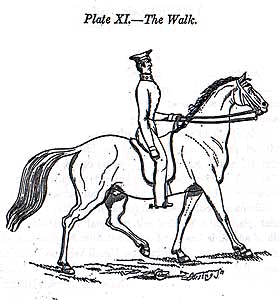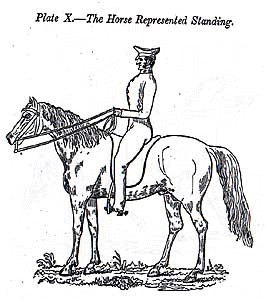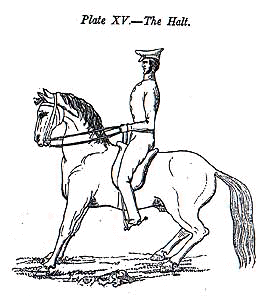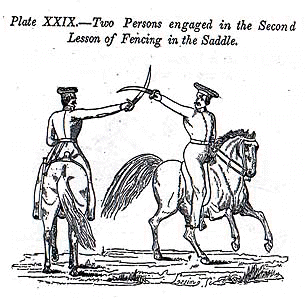Position of the trooper, mounted 270. -- (Plate 51.)
The buttocks bearing equally upon the saddle, and as far forward as
possible;
|
|
The pictures and descriptions below are from my original Poinsett's Cavalry Tactics Field Manual
Below my comments additional pictures from another military manual that taught horsemanship at the USMA
I have placed them here to illustrate and describe the seat, position and use of the body using the mid 19th century military seat.
Some say a picture is worth a thousand words, I say a picture can misconstrue as well as enlighten and interpretation is up to the individual after reading the text, which is (at least to me) clear and precise whereas the pictures are not and are conflicting in many areas, you should draw your own conclusions.
Position of the trooper, mounted 270. -- (Plate 51.)
The buttocks bearing equally upon the saddle, and as far forward as
possible;
|
|
The use of the legs. 278. -- The legs serve to urge the horse forward, to support him, and to aid him in turning to the right and to the left. Whenever the trooper wishes his horse to move forward, he should close the legs by degrees behind the girths, causing their effect to correspond with the sensibility of the horse, taking care neither to open or elevate the knees, of which the bend should always be pliant. The trooper relaxes the legs by degrees as he closed them. Length of the stirrups. 331 -- Having commenced the exercise, the instructor assures himself that
the stirrups are properly adjusted. Position of the foot in the stirrup. 332. -- (Plate 60.) The stirrup should support only the weight of the leg.
The foot ought to be inserted one-third of its length, the heel lower than the toe. |
My own observations:
Seat: In the plate illustrations one (plate 51) is correctly illustrating what the printed instructions describe as far as seat goes. The other, (plate 60) shows something different due to the forward placed leg. It seems to be pushing the rider back on his buttocks, at least that's what it looks like to me. Plate 51 shows a good example of a rider sitting in the middle of the saddle, and staying as close to his horse's back as is allowable considering his saddle type and its suspended seat. There is not much disagreement that the rider's seat must be placed in the middle of the saddle where it will be most secure for combat, less injury to the horse and to keep the rider from interfering with the horse's motion.
Upper body position: In Plate 51 the rider's upper body looks forced, back hollowed, head behind the vertical a bit. The printed instruction warns against hollowing the back by throwing the shoulders back too far. Arms would have to be acting stiffly held in this position although the printed instructions note this form for use of a snaffle bit, which differs from modern snaffle use.
Leg position: This seems to be the part that is challenged as something that modern riders have to change. The braced leg means the stirrup leathers are not directly below the stirrup hanger but are pushed unnaturally forward. Some riders I see on the reenactment battlefield mistakenly believe this is what constitutes a military riding posture. Others may do it unconsciously because of several reasons; they are stiff due to fear or tension, don't use their legs and seat to direct their horses because they never learned the aids or are riding solely with their hands. This is where I see the most abuse to the horse itself, mainly riders using their reins to steady their own balance at the horse's expense.
Plate 51 looks good to me, the rider is relaxed in the leg at rest, unlike his upper body. This is a natural leg position at rest and not demanding anything of his horse.
Plate 60 has many flaws and differs greatly from several areas of instruction. The most amazing part that initially got my attention is how the stirrup strap is attached to the saddle. The shabrique hides the placement but by following the strap up in an imaginary line it would be safe to assume the strap would be attached on the same line as where the neck meets the withers.
From the written instruction in Poinsett's this leg position is all wrong. The position would be impossible in practical application (see Use of the legs, above). It also would be too long in the stirrup unless the stirrup hung where it should be and not out at the farthest reaches of the leg. (see Length of the stirrups, above) Instructions advise the trooper to insert his foot 1/3 of the way in but the illustration shows a foot placed in the stirrup all the way to the heel (which would be the only way the trooper would be able to keep the stirrup on his foot in this flawed illustration).
Along with the unusual placement of the stirrup strap I also note a bad placement of the breast strap. If placed in such a way it will hinder the shoulder movement of the horse.
Much thanks to Todd of The Military Horse site for additional illustrations below which offers a supporting view of use of the leg. Illustrations from Hershberger's Horsemanship published by the riding instructor at the USMA in 1844.
 |
 |
 |
 |
I have many other illustrations from horse training and riding manuals of the 19th century to illustrate the leg position as on the horse's sides and not braced.
Article written by Linneus Ahearn